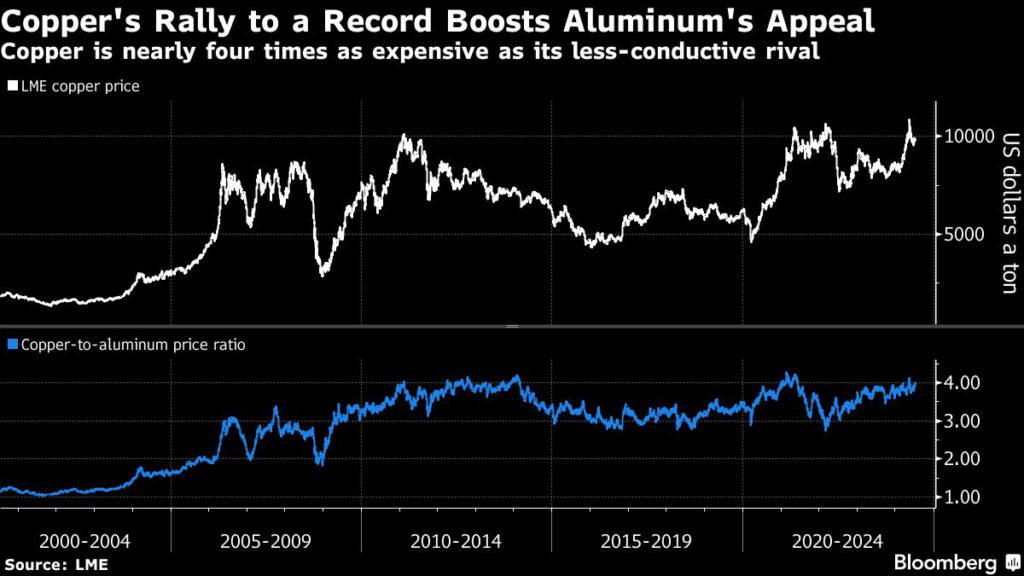
For months, as copper spiked to record levels and then fell back down again, one key question has bubbled up across the metals industry: What is China’s state grid operator up to?
The world’s single biggest buyer of copper, State Grid Corp. of China, has slowed its purchases of copper wire this year, while at the same time ramping up purchases of aluminum wire, a cheaper substitute. While arguably a natural response to soaring copper prices, the change has ignited a debate over whether there’s something bigger going on — if one of the metals industry’s most important but opaque buyers might be undergoing a shift in policy that could rock the global market.
The possibility of large-scale substitution of copper in China’s power networks would have a meaningful impact on global demand, and some traders are touting it as a reason to bet against the broad consensus for growing shortfalls and rising copper prices in the coming years. China is the world’s largest copper consumer, with more than a quarter of global supplies being used for Chinese electrical cable.
Still, traders and industry executives said that it’s far from clear that any such major push is underway — small-scale substitution away from high-priced copper has been a long-running theme in the market, and tends to attract more attention whenever prices rise. Others suggested that the shift this year was only a temporary response to spiking prices.
“It’s not a new topic in China but an ongoing one for years without significant progress from the state grid,” said Chenfei Wang, head of wire and cable at CRU Group in Shanghai. “The topic becomes ‘hot’ whenever copper prices rally.”
Copper has retreated about 13% from the May record of $11,104.50 a ton on the London Metal Exchange amid profit-taking by investment funds and muted Chinese demand. The futures fell 1.6% to $9,653.50 a ton as of 3:37 p.m. in London.
Copper has been the metal of choice for conducting electricity since the days of Thomas Edison, but aluminum — less conductive but also lighter and cheaper — has long been used as an alternative. Because aluminum is less conductive, aluminum cable must be larger than copper cable to transmit the same quantity of electricity.
For uses where weight is important but there is no constraint on space, like overhead power transmission lines, aluminum is commonly used. Where space is at a premium, such as underground cabling in city centers, copper wins out. Aluminum also has a reputation for being less safe, cemented in the 1970s as high copper prices triggered a boom in the use of aluminum in home wiring and a wave of electrical fires.

Globally, substitution has reduced copper consumption by around 1% to 1.5% per year over the past decade, according to a recent presentation from the International Copper Association.
While the global copper market is well supplied for now — in large part due to weak buying in China — there is a widely held view that the industry is headed for large deficits in the coming years, which could drive prices dramatically higher.
In China, copper is legally required for certain types of wiring or power generation usage, so traders are on high alert for any sign of a policy shift.
The world’s biggest utility, State Grid supplies electricity to more than 80% of China. However, it only uses public tenders for certain purchases, and even then doesn’t always disclose whether it is buying aluminum or copper wires, making buying decisions difficult to track.
But several analysts and industry executives said State Grid had slowed purchases of copper and wire cable in recent months, as copper prices soared to a new record driven by buying from bullish investors.
One major supplier to the grid said that his company’s sales of copper cable were down about 20% in the second quarter.
The state grid’s insulated metallic power cable tenders slowed since April due to high copper prices, although some activity resumed after prices retreated, said CRU’s Wang.
Meanwhile, sales of aluminum cable have been rising sharply. State Grid’s tenders for aluminum cables rose by 40% to 718,000 tons in the first four months this year, according to Shanghai Metals Market.
And there has been growing discussion of substituting copper with aluminum.
Already in China, as in much of the world, aluminum is used in high-voltage overhead power cables, where its light weight is an advantage. But China still uses about 7.5 million tons of copper a year in electricity cable, compared with 3 million tons in aluminum, according to data provided at an industry conference organized by the China Nonferrous Metals Industry Association in Shanghai on July 3.
“It is at an opportune moment” to promote aluminum substitution to copper, the association’s chairman Ge Honglin said at the conference earlier this month, referring to the country’s abundant aluminum resources, high reliance on copper imports and aluminum’s economic competitiveness over copper. Aluminum has achieved “industrialized” use in low-voltage grids, said Ge.
One cable supplier to State Grid has increased its aluminum purchases by almost 50% in the past couple of months, according to a person familiar with the matter. Still they cautioned that the surge in demand for aluminum cables appeared to be for use at construction sites – and therefore temporary installations – rather than use in the power grid.
State Grid didn’t respond to a request for comment.
Italy’s Prysmian SpA, the world’s top cable maker, is also skeptical about the prospects of a broader, global shift to aluminum, unless the industry is faced with real shortages of metal.
Prysmian’s customers in fast-growing areas of usage – such as ultra-high-voltage cables to connect new renewables projects to regional grids, or cables for use in artificial intelligence data centers – prefer copper because it is more efficient and reliable, said chief sustainability officer Maria Cristina Bifulco
“Honestly, we have not seen a shift driven by potential shortages or fears over the copper price,” she said.
Still, it is clear that the recent high copper prices are having an impact on some corners of the market. “Thrifting,” some of which included aluminum substitution, has already reduced copper demand by 400,000 tons, Citigroup Inc. analyst Max Layton, said in a recent interview.
“The likelihood of a policy shift is on the rise in our view,” Citigroup analysts wrote in a recent note. “Large-scale substitution to aluminum, if realized, poses a risk to limit the upside in copper price.”
Comments